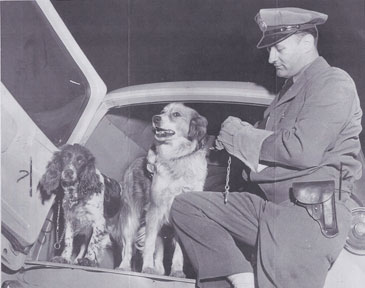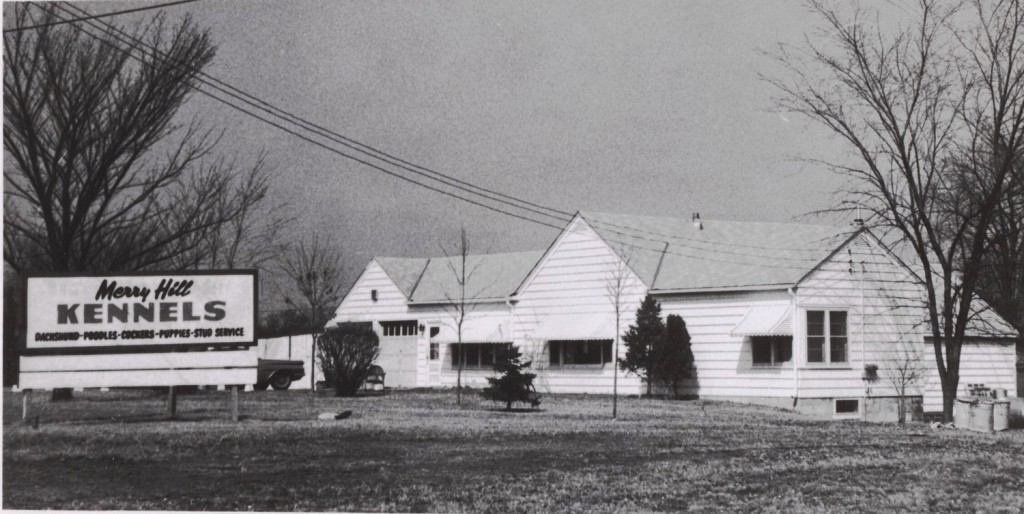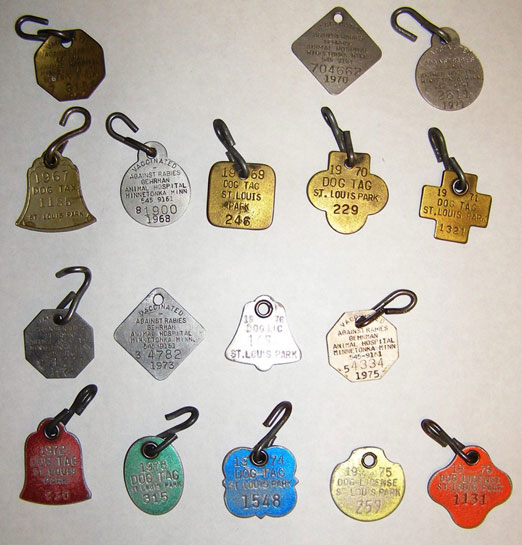Admittedly the history of dogs and dogcatchers in St. Louis Park may not seem like an important area of study. But in this age of leash laws and clean-up-after-yourself laws, it is interesting to go back to the days when stray dogs were a fact of life. Laws about other animals in the Park tell us a great deal as well. Also see Veterinarians.
The position of Pound Master goes back to at least 1901 when George N. Moore was appointed by the Village Council.
On August 1, 1902, a law was passed preventing animals and poultry from running at large, providing for the impounding of such animals and establishing a dog pound. The ordinance also prohibited horses, sheep, goats, swine, mules, geese, or poultry from herding or grazing in the streets. Owners would be fined 50 cents for each animal impounded. The pound keeper was to hold an animal for four days, and if not redeemed, authorized to sell the animal to the highest bidder.
In April 1904, an ordinance was passed to license dogs: $2 for dogs and “spladed bitches,” and $4 for “non-spladed bitches.” The Council was to appoint a dog catcher each May. It would cost the owner $1 to retrieve his dog, with the fees going to the dog catcher. If the dog was not retrieved after three days, it would be sold or put to death by chloroform.
In 1905 the dog catcher was Dennis Redmond of Minneapolis.
In 1906 the Village levied a dog tax, perhaps for the first time.
In 1907 a Mr. Hinkle was appointed Pound Master. He received no salary, but may have received a portion of the fines he collected.
In 1909 L.L. Bradley was named Sidewalk Inspector and Pound Master, at a salary of $45/month.
In 1911-13 Frank Pelo served as Pound Master.
In 1914 Pound Master was George N. Moon. In 1914, again, the dog tax was controversial.
In 1916, Marshall F.W. Hudson was reimbursed $2 for burying two dogs. That year the Minneapolis Council issued a dog muzzling order that was opposed by members of the Council.
In 1916-21 George Moore was back as Pound Master.
1926 ORDINANCES
Along with most other ordinances, the animal-related laws of the Village were codified in the 1926 reconciliation of Village ordinances.
- The morals and decency section of Ordinance A-4 counted as unacceptable animals copulating in public.
- Ordinance A-5 regulated the keeping of domestic animals.
- Ordinance A-8, passed on July 30, 1926, provided for an annual dog tax of $1.00 for males and $2.00 for females.
- Under the public health and safety section of Ordinance A-16, it was illegal to publicly exhibit or exercise or let to any animal of the opposite sex, any stallion, jackass, bull, board, ram or bill boar. Cruelty to animals was outlawed, including cock fighting. It was also illegal to hitch an animal to a lamp post, tree, hydrant, water trough, or drinking fountain.
- Ordinance A-17 regulated animals running at large
Also in 1926, it was reported that three people
were all “quite badly bitten” by the Bertleson dog. The constable was finally reached by telephone and they caught the dog we hope, have shot it, for it has molested pedestrians before. The injured were attended by physicians and we hope nothing serious will develop. (Hennepin County Review, August 19, 1926)
On March 1, 1929, Louis Vlianon was charged with allowing his vicious dog to run at large in city streets, and was ordered to muzzle his dog.
On February 18, 1932, the position of Village Dog Catcher was created. Previously, the Marshall was given the task of catching strays and putting them to sleep after 5 days. Richard Murrell was appointed, and his remuneration was that he could keep half of the fees he collected.
In 1934 Murrell was fired and replaced by Nels Larsen.
In 1935 DeMuth Kennels was located at 5254 Excelsior Blvd., run by John A. and Hazel DeMuth.
Legal records from 1935 show that a Mr. Elias was fined $5 when his “vicious dog” bit a postman.
The March 18, 1939 meeting of the Village Council had much dog business. The State Sanitary and Livestock Board notified the Village Council that the dog muzzling order had been extended for six months. Dr. Fitch offered to take care of all unmuzzled dogs picked up for a yearly fee of $250. The Mayor asked Alfred A. Miller if he would take the position of dog catcher, but he was very much against the muzzle law and declined. Not wanting to avail themselves of the Animal Rescue League (dissatisfaction with their methods) they had no choice but to take Dr. Fitch’s offer, although they would advertise for a new dog catcher in the Spectator newspaper.
For three weeks in 1941 there was a rabies epidemic in the village, with more animals put down as a result of panic than was necessary. There were no human casualties.
In April 1942, the Excelsior Blvd. Boosters Club wrote the Village Council requesting a dog confinement law.
In 1943, E.W. Smith was hired as dogcatcher. He would take his prisoners to Dr. Fitch’s Pet Hospital, where they would be held for three days before being destroyed.
1944 saw a spate of dog poisonings in the Brookside area. At least nine dogs had ingested strychnine and were brought to Dr. Fitch. One dog had been poisoned, saved by the doctor, and then finally poisoned again.
In October 1945, neighbors complained of barking dogs at the Fitch Pet Hospital, accusing Fitch of leaving town and putting “boys” in charge. Fitch replied that those dogs were there as a result of him being the dogcatcher, which he had been since 1930 and that he didn’t want to be. He was replaced by the Hennepin County Animal Rescue League.
In March 1946, a Mrs. Peterson at 3106 Inglewood had five dogs that were creating a nuisance. She applied for a kennel license but was denied.
In April 1946, Dr. Fitch’s son, Ernest L. Fitch, Jr., submitted a request to start a mink farm at the family house at 5700 W. Lake Street, starting with 15 and expanding to 45. The request was denied.
A 1946 request by Mrs. Hartmann to shoot squirrels on her property was referred to the police department.
From at least 1947, Mr. Harald N. Johnson ran a mink farm on his property at 4344 Brook Lane.
In December 1947, in the days before spaying and neutering dogs and cats was routine, roaming dogs were commonplace. After seeing pictures of big dogs menacing small children, the Village Council began interviewing for a dog catcher.
In March 1948 Alfred Hay was appointed dog catcher. He would be paid $2.50 per hour, part time, which included the cost of renting a truck. Hay also owned a taxicab company.
In April 1948 the dog ordinance was amended for the first time since 1926. It called for all dogs to be licensed, and vicious dogs to be confined. Dog licenses sold for 25 cents. The Village paid Dr. Fitch 75 cents a day for each stray boarded, $1.25 for dogs injured in an accident, and $1.00 to dispose of a dog.
Another law amended in March 1948 was the gun law. It allowed citizens to kill diseased, dangerous, or injured animals. One could also get a permit from the Chief of Police or the President of the Village Council to kill rabbits, crows, or skunks on your own property.
In June 1949 Alfred Hay resigned as dog catcher, and was replaced by Lew Kolstad, from Robbinsdale, on the same terms. In September the dog catcher was given jurisdiction over calls about stray cats.
Dr. Fitch was named dog pound keeper for 1950.
In June 1950 Mr. and Mrs. Edward Dobie of Robbinsdale asked to use the old WDGY building on Wayzata Blvd. as a dog kennel and residence. The station had moved in 1949. They were denied. Then in November, Mrs. Dobie requested a kennel license for seven acres of land east of Highway 100, north of the Great Northern tracks, south of Cedar Lake Road. She was denied again.
In the summer of 1951, the Village’s part-time dog catcher, Lou Kolstad, resigned. In the interim, Park police would pick up the slack.
Meanwhile, in August 1951, Dennis J. Keefe of 4116 W. Sunset Blvd. wrote to Dr. Darby that rats were invading his neighborhood.
Dogs were running wild: Letters from the principal and Superintendent of Schools told of a stray dog problem at Lenox in September 1951. The Health Inspector noted 5 dog bites in 1951.
In September 1952, a couple complained to the Council of “continual marauding of dogs” in their garbage cans.
In May 1952, 19-year-old Bill DeMuth was hired as Village Dogcatcher. He had served Robbinsdale in the same capacity. [John DeMuth hired as dog catcher, Don DeMuth his Deputy.] Bill took the caught dogs to his father John’s Merry Hill Kennel at 9920 Wayzata Blvd. (which at that time was still in Minnetonka) and put the unclaimed “good” dogs up for adoption. The elder John DeMuth had raised dogs since 1918. An article in the Dispatch claims that the dog catcher could expect to be bit about once a week! Cruising hours for the winter of 1953-54 were set at 2 hours/day, 5 days/week, plus any calls from school principals and the street department.
In 1952 someone suggested that St. Louis Park host a regional dog pond. Could that be pound?
From January through March 1953, the dog catcher had picked up 120 dogs. In March 1953 the Village passed a controversial confinement law, effective April 1, 1953. The ordinance banned dogs running loose on playgrounds, and ordered them leashed or confined from April 1 to October 1. On March 30, 1953, a huge dog meeting was held at Union Congregational Church. One Otis Dypwick of 3645 Huntington had a petition of 571 who were against the ordinance. He stated that leashing dogs makes them vicious, and that his dogs never bothered his chickens. The meeting was peppered by personal accusations and many harsh words were said. The Minneapolis Tribune published a story on the April 1, 1953 leash law with this photo of William DeMuth and two of his charges. A wry story in the April 22, 1953 Echo stated that Park dogs had been pushed into the lowest form of dogdom by the ordinance, driving dogs to suicide and depression.

In June 1953 it was suggested that the old veterans’ housing units be used as a dog pound. Probably didn’t happen.
A step-up in dog catching is evidenced by a complaint by Marvin A. Holt of 3920 Lynn, who complained that his boxer got picked up a short distance from his home. He leveled a charge of “a mass and indiscriminate catching of dogs for financial returns” at a September 23, 1953, Village Council meeting.
In February 1954 the Village requested assistance from the Hennepin County Animal Rescue League to set up its own dog pound. That May, an agreement was reached with the Animal Rescue League, which acted as City Dog Catcher through at least 1957. The pound must have still been at Merrihill [Merry Hills] Kennels, because in July 1954 the kennel was busted for having a short wave radio on the SLP frequency. The Village ordered it removed, but later agreed to put a radio in the dog catcher’s car. Efforts must have been successful: Mr. Nelson of 37th and Kipling demanded a refund of the $10 fine he paid when his lab puppy got picked up at Brookside School (denied). Mrs. Bates at 50th and Interlachen met the same fate.

On May 10, 1954, the Animal Rescue League was contracted to patrol for two hours/day, five days/week. Dogs were held for five days. The Village paid them $400/month, and the League was to retain 40 percent of impounding fees.
In May 1954, the folks on the 2900 blocks of Princeton and Ottawa complained of rats.
In 1955 it wasn’t dogs but rats, cats, and chickens all living together in an old barn at 3021 Maryland, a house built in 1895. Other complaints were about Guy Newall, 2601 Xenwood, who had a kennel license and kept six dogs. Houses were built around him, though, and the new neighbors weren’t fond of all the dogs.
The Animal Rescue League raised their rates on July 1, 1955, despite the bid from Mrs. DeMuth to do the job for $350/month plus 40 percent of the fines.
At the urging of the Animal Rescue League, the City Council passed an ordinance prohibiting giving away chickens, other fowl, or rabbits less than 30 days old, after an Easter giveaway promotion led to an outbreak of salmonella. Golden Valley had no such ordinance, and staged a baby chick giveaway in 1963. The Animal Rescue League persuaded the three sponsors of that event, including Warner Hardware, to surrender the remaining 500 chicks, and they were trucked off to a farm.
In 1958 residents were reminded to leash their dogs between April 1 and October 1. In November 1958, Ordinance 659 was passed, regulating and licensing dog kennels. The Animal Rescue League was still the official dogcatcher. Their number was FRIENDS.
In November and December 1959, there was a spate of dog poisonings in the Minikahda Oaks neighborhood (Huntington, Randall, 31st). Vets found that the dogs had been killed with strychnine.
Dr. Ellen Z. Fifer served as Public Health Officer from 1959-1966, and reported that when a dog bit a child, she told the dog’s owner that it had to be quarantined: kept inside and observed for 10 days. Few cases of rabies were found.
In the early 1960s one could get a permit to use a rifle to kill wild rabbits, muskrats, and other animals that were considered a nuisance.
Animal contractor was the Animal Rescue League of Hennepin County in 1960-62.
For three winters, Dave Benson’s dog Queenie trotted off to 49th and Quentin at 7 AM to wait for postman Arthur Bolnik to come along at 10. Queenie would then accompany Bolnik on his route, every day without fail. Leash laws were in effect in the summer, so Queenie only had her route in the winter.
In March 1961 Health Officer Dr. Fifer reported that an “outbreak” was traced to a baby chick.
As of May 1961 dogs had to be leashed year round, instead of just in the summer.
In 1962 there was a move to regulate and license animal training schools.
In 1965, the City set new dog catching fees, after consulting those of neighboring jurisdictions:
First pickup: $6
Second pickup: $10
Third pickup: $20
Fourth pickup: $20
Boarding: $1.25 daily
No license fine: $5
In 1967 animal control was contracted to B & E Animal Patrol, D.J. Bora, President. There were complaints about stray dogs, and B & E was asked to step up patrols. There was talk of empowering police to issue tickets for unleashed dogs, but we don’t know if that actually went through.
1,981 dogs were licensed in 1971.
An April 1972 article said that dogs running loose in St. Louis Park had better increase their speed or risk capture by the B & E Animal Patrol Agency, acting as the City’s dog catcher.
In the mid 1970s the City began to get fed up with pet owners who did not clean up after their charges. There were complaints that children were coming home from playing in the local park, covered with dog poop.
In 1976 the Council took the drastic step of banning all dogs and cats from public parks, but soon acceded to a “pooper scooper” law.

